#Spadroon
Explore tagged Tumblr posts
Text
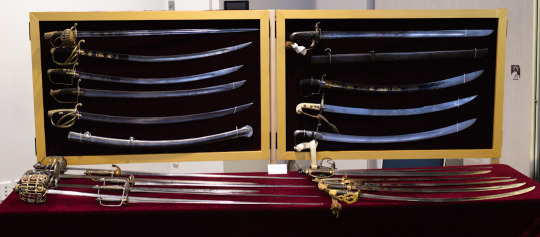
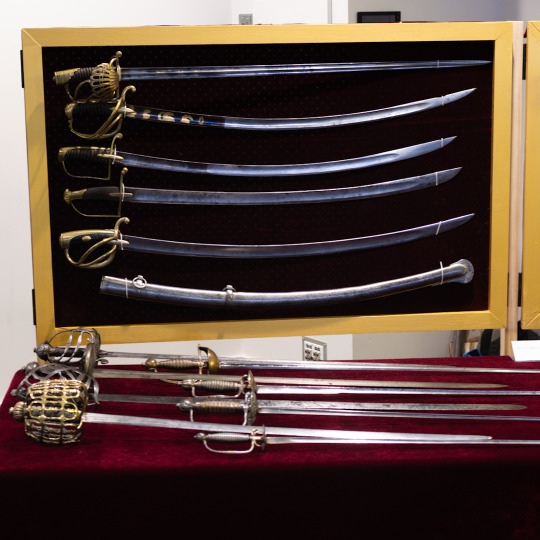
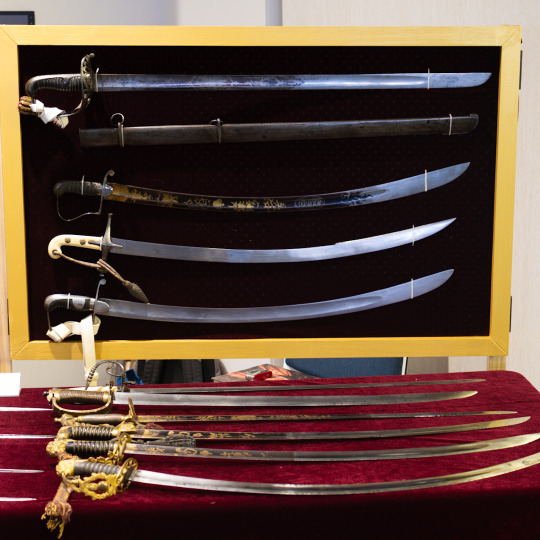
Photos of the sword display I had at last weekends excellent Auckland Blade and Knife show.
Was great to see meet with New Zealand's very talented knife makers showing off their work. Truly inspiring works of art.
For my display I opted to have a selection from the collection that covered a broad range instead of focusing on the one topic.


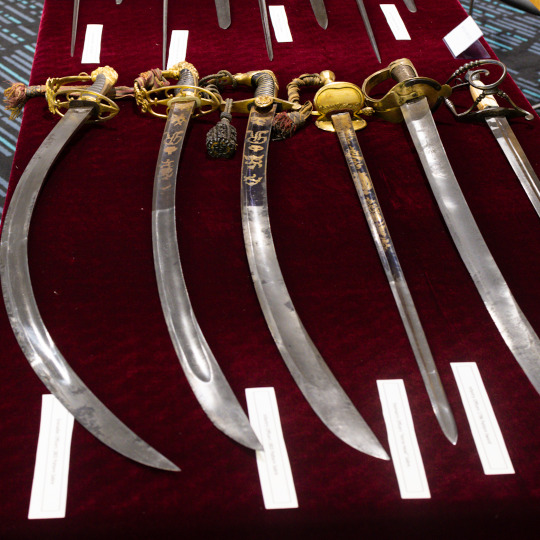
It was also my first use of the new boards I made after the last show. These are on their own stands giving me more table space.
Despite being a bit rough about the edges (remember folks, measure twice, cut once 🤣) they worked well. The next challenge is to improve on how the swords are mounted. Cable ties work great, but they're fiddly to pass through the cloth backing while trying to hold up a sword at the same time.
My thanks to The Auckland Blade Show for organising such a great event and for allowing me to participate. Shows like these are key to showing people just what is available and possible.
#swords#antiques#napoleonic wars#military antiques#british army#sabre#cavalry#Shows#Displays#Walloon Sword#Schiavona#Smallsword#Baskethilt#Spadroon
148 notes
·
View notes
Text
The sword of the day is the spadroon.

This is a European and American sword that was in use in the late 17th and early 18th centuries. It is a midpoint of sorts between the smallsword, which had no sharpened cutting edge, and the much heavier broadsword. As a fairly light sword, it is able to make quick and agile cuts while also maintaining an excellent profile for thrusting. After falling out of use as a military weapon, the spadroon continued to be used in a ceremonial capacity as an officer’s sword for quite some time.
75 notes
·
View notes
Text
#sword#swords#spadroon#british#british army#georgian#18th century#antique#antiques#Thierry the sword guy#youtube
37 notes
·
View notes
Video
youtube
Why Sabers dominated over Smallswords & Spadroons for Infantry Officers
#youtube#18th century#19th century#Swords#smallswords#spadroons#Sabres#Military history#Napoleonic wars
18 notes
·
View notes
Text








Some shots of me, and many others, at a recent event
We did some napoleonic navel boarding and lots of duelling
Also featuring me holding a spadroon
43 notes
·
View notes
Text
how i know im obsessed with a game - i start making pseudo dlc for it just so that i can continue obsessing over it and eventually spiral off into my own nightmare dimension
so in a hypothetical AC6: CORPORATE CEASEFIRE dlc, on a NG+ playthrough after the ice worm shows up, arquebus would call you and say "hey while we prepare to formalize this agreement with balam about murdering the PCA, could you go do some chores for us? thatd be great" and they send you off to go murder some people



from left to right: Elysium Technologies, the Wayfinder Group, and Kaleido Prism Dynamics.
they're a trio of corporations who arrive on rubicon to ensure that NOBODY finds the coral. don't mistake this for heroism - these are the corporations who invented Coral Substitution Technology and theyre here to protect their product line from being invalidated. arquebus and balam want them dead but haven't had the time to get around to performing warcrimes on these clowns.
they've only very recently shown up, and so they're still establishing a proper base of operations to operate from. Raven's job is to hunt every last member of their intercorporate alliance and ensure that they dont get to conceal the true location of the coral.
Mission 1 would be about assaulting their combined beachhead and scattering the three groups to the winds. the mission is a funhouse of destructable targets, fuel storage tanks, generators, berthed warships, almost half the level is filled with paytargets. you kill at least one member from each of the corporation's in-house AC squads here, giving them a reason to come and hunt you down.
Mission 2, 3, and 4 would be about hunting each corporation down and dismantling their in-house AC teams. each mission ends with a nightmare slugfest between you and their AC squad, and blowing up a mobile transport carrying that corporation's essential staff.

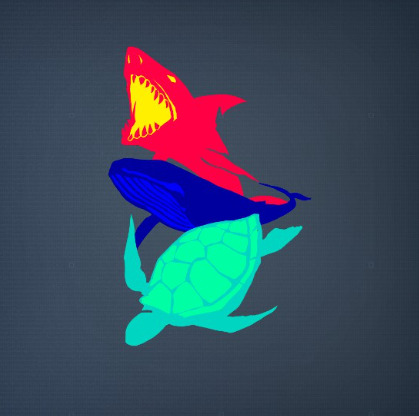
Elysium Technologies focuses on building lightweight ACs that know how to zoom across the battlefield at top speed. they also have an obsession with kinetic weaponry, seeing it as more "Pure" than other types of weaponry. they favour assault rifles and shotguns for high-damage hit and run guerilla warfare.
their in-house AC squadron are the Wavebreakers, so named for the "origins of life so many years ago". there are only three: Shark and Whale, the primary assault team, and Turtle, their artillery support. during Mission 1, you kill Turtle before the others can deploy and send Shark and Whale into a vengeful frenzy in Mission 2.

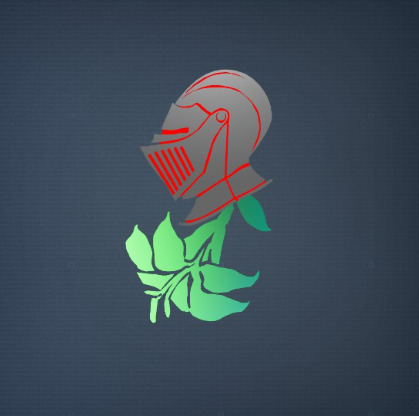
The Wayfinder Group focuses on building jack of all trade ACs - middleweights with decent AP, weight, and boost speed. they're hyperfixated on explosive weaponry and always give each AC at least one Songbird grenade cannon for you to deal with. they're also heavily into the knighthood aesthetic, which explains why they're the inventors of most melee weaponry introduced in the DLC.
their in-house AC squadron are the "Rustbuckets", a collection of heartless vultures who steal parts off the ACs they destroy. their members are Misericorde, Spadroon, Paramerion, and Estoc. whoever you destroy first in Mission 1, the parts of that AC will be used to upgrade the parts of the other three in Mission 3.


Kaleido Prism Dynamics focuses on building heavyweight artillery ACs designed to murder you from a mile away. they're energy weapon fanatics and usually build with quadlegs to take advantage of the hover functionality. they heavily favour multi-lock missiles and long-range sniper weaponry. conversely, their ACs are usually easy enough to kill once you get close enough.
their in-house AC squadron is "Sunspot LTD", a mercenary company on permanent hire to Kaleido Prism Dynamics. they're easily the most professional and coordinated squadron and essentially never deploy alone. they dont have proper callsigns but instead refer to each other as mere numerical codes. in Mission 1, you kill Sunspot 3. this causes the rest of them to arrange an ambush in Mission 4, as they're well aware that they can't beat you in a fair encounter.
Mission 5 of the DLC would see you go up against their crowning glory - AC: "CEASEFIRE", made from an assortment of parts from all three corporations working in concert to create something to protect themselves from Raven. once you destroy "CEASEFIRE", the three corporations promptly decide to get the fuck off rubicon.
8 notes
·
View notes
Text
Schnee family sword names have had my interest for quite some time now. So here, I'll be figuring out what they look like, along with their names.
Up first, we have Nicholas Schnee.

This man is quite literally a knight in shining armour. But his sword isn't one of the Oakeshott typology. According to The World of Remnant Short, Nicholas actually uses a sabre and pistol.
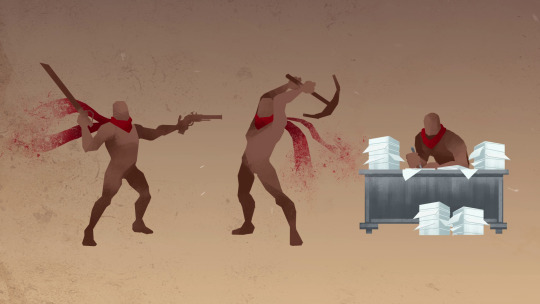

Contrary to what may be popular belief, there is a discipline for this style of fighting in HEMA, and yes, it involves using a sabre - specifically either a spadroon or a boarding cutlass according to David Rawlings.
Regarding what sword he would use, I believe his hands are very big. He was a miner, after all, and he's clearly shown wielding a pickaxe as well.
Therefore, I think his sword would be a two-handed sabre, like this.


More specifically, it would have the swept hitl guard, and the grip. But I picture the blade being a little wider, and the pommel having a more 'flowery' shape. Something like this.

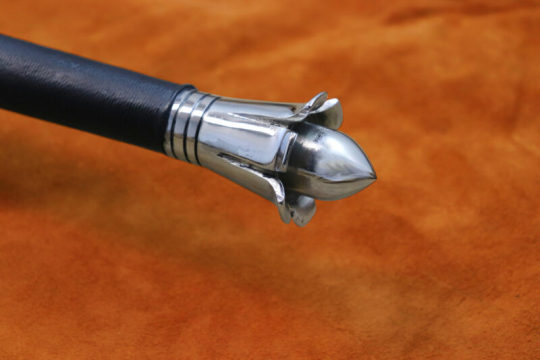
Separate thought here: take note of the pommel in the picture. Does it look a bit familiar?

I think so. :3
Regarding a name, I think this sword is called Wurzel, which is the German word for Root.
The reason being that Weiss explains how her father wasn't the man who started the Schnee family, and she also refuses to be the last of it.
I agree. Her motive is honorable. Jacques was a jackass after all.
But something tells me that the true Schnee legacy doesn't go back much further than Nicholas himself. Therefore, I view Nicholas as the Root of his family tree.
Incidentally, I believe the sword was forged using part of a meteorite, which landed in the mining areas in Mantle, hitting a vein of ice and absorbing the power from it.
From the unique metal combined with the ice dust, the blade was especially good at freezing through objects and other weapons. The sword was retired from service not long before Nicholas died and has seen no action since.
#rwby#schnee family#schnee swords#sword types#sword names#nicholas schnee#willow schnee#winter schnee#weiss schnee#german names#flowers
104 notes
·
View notes
Text

The hilt of a very interesting spadroon reportedly carried by a Hessian soldier during the American Revolution. I hope to get more pictures and information about this sword later. But in case I don’t I thought I’d post the one good picture I do have here.
#sword#antique swords#american revolution#revolutionary war#history#military#military antiques#military history
4 notes
·
View notes
Text
Monday Snippet
Thank you for the tag @del-stars <3 Since I don't have a new project to currently work on, let me shamelessly self-promote the first chapter of Forget Me Not, which you can read here.
“Is this your spadroon poking me in the back? Or are you just happy to see me?” Fuck. “It’s my spadroon”, Remus hisses back, unable to come up with a better excuse. Tightening his grip around the prince’s mouth, he watches intently as the soldiers finally pass by. Once their footsteps and chatter recede and their surroundings can be deemed safe again, Remus finally allows himself to breathe. Only for the prince to lick squarely across his palm. “What the-“ Appalled, he draws away his hand, shaking off the saliva. “You’re worse than fucking a dog, actually”, he grumbles. The prince cackles as he saunters away. “So, I’m told”, he replies, grinning way too pleased with himself for someone behaving like a toddler. However, it does have something endearing to it.
Couldn't resist joining in on the funny scenes. Here is @del-stars 's snippet if you want to read it. It cast a big grin on my face.
np: @magicbeings and whoever wants to.
6 notes
·
View notes
Note
if you could have any sword you've ever drawn which would it be? (other melee weapons count too)
That's a little tougher because as much as I love the look of the weapons I draw, I don't think I'd like having them around THAT much compared to firearms and especially random little objects from the 19th century. I recently bought a WW1 trench lighter made from shell casings, that's what I love to just own. If I had the opportunity and means to own a proper cool sword it would probably be something I haven't had the opportunity to draw yet, aka a smallsword/spadroon because I low-key want to get into that type of fencing .w.
11 notes
·
View notes
Text


Playing with different backgrounds for displaying swords on. The blue is quite a cold colour, especially with all the bare steel. And at times the bluing also gets lost. I think the burgundy works well, so I will probably use that for the coming display. The top two swords are Georgian era non-regulation infantry officers swords. While the bottom two are 1796 Pattern swords, the one with the boatshell guard is for General Officers or Dragoon Officers dismounted service while the one with the Pas d’Ane guard is for infantry officers


#swords#British Army#Spadroons#Red vs Blue#antiques#displaying antiques#1796 Pattern Sword#five ball spadroon
118 notes
·
View notes
Text
I thought Flametail's sword was like a spadroon/straight saber, but it actually has the straight crossguard as well, and the blade is maybe a little wide at the base for a spadroon? I guess that would make it like a simple sidesword or the transitory phase between arming sword and sidesword
#I know all these words are applied after the fact#And extra hand protection was being added to arming swords when the smith could surprisingly early#So#I don't know I just think it's neat
0 notes
Text
Why do sword people online say spadroons are bad. What's wrong with them.
0 notes
Text
-going into the woods with my saw, hooks, crossbow, machete, spadroon, dagger, meat cleaver and four sickles to do very normal things-

Inventory, June 2024
3K notes
·
View notes
Text
The Watchers of the Shrouded City
Scholars among those who wait in the dark.
Deep in the Labyrinth there is a vast hollow, a cavernous chamber of shallow grey water under a sky of strange stars. In this gloomy sub-realm, at the center of the ghost-haunted sea, there sits a tall, circular island bounded by concentric rings of stone terraces. Upon these terraces are battlements and hollow houses, libraries and tombs, and gardens of strange underworldly plants. Ghosts dwell in this city as well, but they are not its masters nor its sole inhabitants. It is the Shrouded City, and it is ruled by the Watchers.
The Watchers of the Shrouded City are an order of militant scholars who train in combat, spellwork, ancient lore, science, and various esoteric fields. They divide themselves into four sub-orders based upon their field of expertise according to an archaic system of divination. From the Shrouded City, they have access to various shortcuts through the Labyrinth and the Deep, allowing them to reach the worlds of the Material by paths unknown to others. There, they gather information and meddle in affairs in order to progress their own interests.
The four orders of the Watchers are the Ordo Gardnier, the Ordo Archivist, the Ordo Castellan, and the Ordo Mortician. Each represents a different view of the city, and corresponds to a stage in the cosmic cycle.
The Ordo Gardnier, first in the cycle, is concerned with beginnings, springtime, the creation of life, the potency of blood, birth and rebirth, healing, and discovery of the self and others. It is seen as the most romantic of the orders, the most likely to pursue its own goals. Its uniform is a rich, slightly dark green.
The Ordo Archivist is concerned most purely with knowledge, with summer, and with illuminating the way. That which can be known can be controlled, so the archivists also focus on control of knowledge. It is seen as the purest of the orders, the most dedicated to the Watchers’ cause. Its uniform is a navy blue.
The Ordo Castellan is concerned with the study of war, tragedy, conflict, politics, and such dismal topics, as well as the autumn. It is seen as the most practical of the orders, for the castellans work to ensure the security not just of the Shrouded City itself but also of the Watchers’ many other holdings. Its uniform is a bloody red.
The Ordo Mortician, last in the cycle, is concerned with endings, death, wintertide, secrets, old bones, and ghosts. It is seen as the most isolated of the orders, for even more so than other Watchers, the duties of a mortician often necessitate much time in solitude. Its uniform is a stark white.
For all four orders, the uniform consists of a greatcoat and a chain of office marking rank, along with trousers or a skirt with stockings, a blouse or shirt, a leather belt, boots or shoes, optional gloves, and a sword. They are, after all, militant scholars, and many of their traditions are rooted in ancient aristocratic norms. As such, a modicum of proficiency with the blade is required of any Watcher physically capable of such. Mostly they prefer one-handed blades, of various makes and heft as the individual sees fit, including rapiers, broadswords, smallswords, side swords, spadroons, saifs, sabres, fleurets, foils, epees, and more.
Students of the Watchers wear grey uniforms and lack a chain of office until their final initiation ceremony, which is only reached after months of rigorous tests of mind, body, and spirit. The initiation requires a sponsor and two other Watchers. The student passes between the blades of the other Watchers, then kneels before their sponsor and pledges loyalty to the Shrouded City, their chosen order, and the pursuit of knowledge itself. Most students come from one of two backgrounds. They may be scholars of note in their own right, with an inquisitive hunger for lore. Alternatively, the Watchers frequently abduct promising children and raise them either in the Shrouded City’s boarding school or else out in one world or another as an apprentice to a senior Watcher.
Ultimately, the goal of the Watchers is knowledge, and the power that it brings. They seek absolute knowledge of all things, and thus power over those things. They are at times ruthless or cruel, yet not without reason or purpose.
Author’s Note: A part of my ongoing Onward Everyday worldbuilding project, an attempt to get an unruly, overgrown fantasy universe into writing. This was written on the 3rd, but it took me a couple days to get it posted.
0 notes